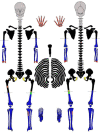Identification of a decedent in a 103-year-old homicide case using forensic anthropology and genetic genealogy
- PMID: 36353312
- PMCID: PMC9639526
- DOI: 10.1080/20961790.2022.2034717
Identification of a decedent in a 103-year-old homicide case using forensic anthropology and genetic genealogy
Abstract
Anthropologists are often the custodians of long-term unidentified human remains though their positions as curators of university or museum skeletal collections. Various factors decrease the solvability of these legacy cases including the passage of time, the loss of provenience for specific cases, and lack of documentation or case records. While anthropologists can contribute important information toward identification, it is often necessary to explore novel and cross-disciplinary strategies to resolve difficult cold cases. In long cold cases, the postmortem interval, in particular, may be difficult to estimate leading to further challenges in achieving identification. Modern advances in radiocarbon bomb pulse dating, isotope analysis, and actualistic studies have contributed to positive identification of unidentified human remains in some legacy cases, but may not be available to all forensic practitioners and law enforcement from resource-poor agencies. Pooling resources, as well as collaborating with professionals outside of forensic anthropology, is a useful strategy to pursue when anthropological methods are exhausted.The case study presented here demonstrates a collaborative approach between forensic anthropologists, forensic genetic genealogists, and law enforcement in a century-old homicide. The dismembered and mummified parts of a male body were recovered in a remote cave in 1979 and again in 1991. Despite forensic anthropologists creating and updating the biological profile over the decades from recovery to present, no identification was made until the application of forensic genetic genealogy (FGG) to the case in 2019. New interpretations of bone microstructure and trauma analysis are presented for the case, alongside the historical documentation and "proof of life" evidence used by the genealogy team. A review of the FGG methods underscores the challenges in this case (e.g. significant endogamy, multiple aliases used by the victim) and the steps taken toward resolution. Ultimately, a combined anthropology and genealogy approach resulted in a confirmed identity for a man who was murdered in 1916.Key pointsForensic scientists should leverage a collaborative, interdisciplinary approach toward human identification.When combined with forensic anthropology methods, forensic genetic genealogy is a valuable tool linking biological and cultural-historical aspects of identity.Forensic anthropologists should review challenging cases in their labs as new methods are introduced and new resources become available.
Keywords: Forensic sciences; forensic anthropology; cold case; forensic genetic genealogy; human identification; investigative genetic genealogy; postmortem interval; skeletal trauma.
© 2022 The Author(s). Published by Taylor & Francis Group on behalf of the Academy of Forensic Science.
Conflict of interest statement
No potential conflict of interest was reported by the authors.
Figures








Similar articles
-
Moving from the unknown to the known: a multidisciplinary approach to the identification of skeletal remains from Sandy Point, Australia.Forensic Sci Res. 2024 Jun 18;9(3):owae032. doi: 10.1093/fsr/owae032. eCollection 2024 Sep. Forensic Sci Res. 2024. PMID: 39296867 Free PMC article.
-
Application and implications of radiocarbon dating in forensic case work: when medico-legal significance meets archaeological relevance.Forensic Sci Res. 2024 Aug 19;9(3):owae046. doi: 10.1093/fsr/owae046. eCollection 2024 Sep. Forensic Sci Res. 2024. PMID: 39435462 Free PMC article.
-
Identification investigations: a collaborative approach to the resolution of long-term unidentified persons cases at the NYC Office of Chief Medical Examiner.Forensic Sci Res. 2024 Jul 20;9(3):owae039. doi: 10.1093/fsr/owae039. eCollection 2024 Sep. Forensic Sci Res. 2024. PMID: 39381494 Free PMC article. Review.
-
Bridging Disciplines to Form a New One: The Emergence of Forensic Genetic Genealogy.Genes (Basel). 2022 Aug 1;13(8):1381. doi: 10.3390/genes13081381. Genes (Basel). 2022. PMID: 36011291 Free PMC article. Review.
-
Law enforcement use of genetic genealogy databases in criminal investigations: Nomenclature, definition and scope.Forensic Sci Int Synerg. 2024 Feb 8;8:100460. doi: 10.1016/j.fsisyn.2024.100460. eCollection 2024. Forensic Sci Int Synerg. 2024. PMID: 38380276 Free PMC article.
Cited by
-
Moving from the unknown to the known: a multidisciplinary approach to the identification of skeletal remains from Sandy Point, Australia.Forensic Sci Res. 2024 Jun 18;9(3):owae032. doi: 10.1093/fsr/owae032. eCollection 2024 Sep. Forensic Sci Res. 2024. PMID: 39296867 Free PMC article.
-
Application and implications of radiocarbon dating in forensic case work: when medico-legal significance meets archaeological relevance.Forensic Sci Res. 2024 Aug 19;9(3):owae046. doi: 10.1093/fsr/owae046. eCollection 2024 Sep. Forensic Sci Res. 2024. PMID: 39435462 Free PMC article.
References
-
- Greytak EM, Moore C, Armentrout SL.. Genetic genealogy for cold case and active investigations. Forensic Sci Int. 2009;299:103–113. - PubMed
-
- Katsanis SH. Pedigrees and perpetrators: uses of DNA and genealogy in forensic investigations. Annu Rev Genom Hum Genet. 2020;21:535–564. - PubMed
-
- Kennett D. Using genetic genealogy databases in missing persons cases and to develop suspect leads in violent crimes. Forensic Sci Int. 2019;301:107–117. - PubMed
-
- Kling D, Phillips C, Kennett D, et al. . Investigative genetic genealogy: current methods, knowledge and practice. Forensic Sci Int: Gen. 2021;52:102474. - PubMed
LinkOut - more resources
Full Text Sources
Miscellaneous

